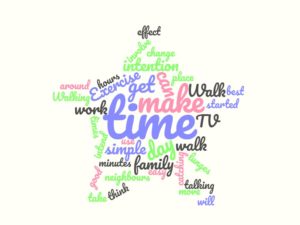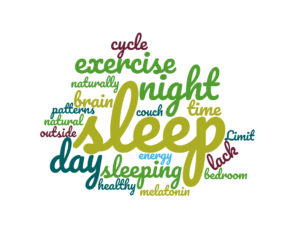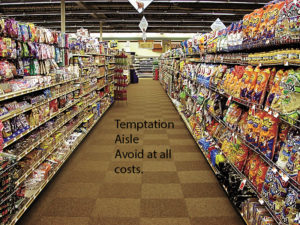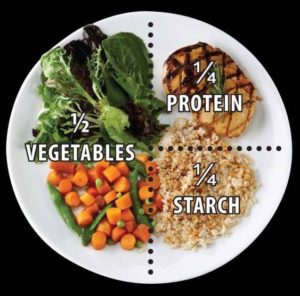Human physiology evolved over millions of years on a diet containing very little sugar and no refined carbohydrates. Sugar cane was originally a fodder crop used to fatten pigs. Sugar gained popularity as a “spice” in the 1600’s when it was introduced into the Caribbean driving the slave trade. Sugar has never been a benefit to our modern world. Here in our 21st century our society is in the grip of a health crisis directly linked to the addictive effects of refined sugar and fats, comparable to the health scourges of tobacco and alcohol. Sugar causes dopamine release in our brains similar symptoms to drug addictions. Sugar is a leading contributor to Obesity and is highly addictive and the cause of poor food choices like soda pop, candy and chocolate,but we do love our sugar!Read more
- May 14, 2018
- Marie
- Uncategorized
- 0 comments
To lose weight we must achieve a slight negative energy balance. We must consume a little less fuel (food) , than we burn to run our body’s systems and perform physical activity.
One major reason for weight gain in our modern society is that portion size over time has been distorted. Read more
- April 9, 2018
- Marie
- Uncategorized
- 0 comments

I started writing this blog as “Making time for exercise”, but stalled with the thought that if we do not have a true “intention” to exercise, all of our plans and wish lists fall by the wayside because we will not follow through on them. I questioned myself how do I do it?
To set in my mind a true intention to exercise, I must mentally pre-program myself, so I see it happening and set it in my mind and commit myself to it. Once I have done that my next step is to plan and decide on the time and place and the how and record it, write it down, text someone my intent.
Better still I invite a buddy along as an extra driving force as insurance.
Exercising for 20 minutes a day will add to your longevity. Adding 20 minutes of light exercise a day adds up to 2+ hours of exercise a week this has benefits not only for burning calories but in increasing our body’s overall health and agility.
Plan time for exercise and make it a regular daily routine habit is even better. It helps to exercise around the same time each day. The key is to build exercise into your life style so that it is not disruptive. Chose times of the day that work best for you. Is it early morning before work or just before supper? or while watching TV? Use those 5-minute advertising sections to put in some body strengthening exercises like squats and lunges. My father, now 93 years old, swears by the arm curls with a couple of cans of beans he has practiced over the years since retirement while watching T.V. as a major reason for his good health.
Start with something simple, Walking is the simplest exercise, it costs nothing to get started. It is easy, safe and can be done anywhere and anytime. Walk around the block in your neighborhood, around the local parks, meet the neighbors. Walk to the corner store instead of driving, walk in the sunlight and get the bonus effect of melatonin stimulation to aid in better quality sleep.
Even at home you can move more through some simple changes to regular household duties, get creative and involve the whole family.
- Do housework to fast music, get the heart rate up, dance for 60 seconds in between chores- feeling a little crazy is good for the soul! (Vacuuming to the sound of the rolling stones cranked up is a great stress reliever.)
- Work in the garden, mow the grass. Rake leaves, prune, dig and pick up trash.
- Stand up while talking on the telephone and exercise on the spot –try high leg lifts , high knee bends or lunges.
- Walk the dog or borrow the neighbors’ dog and take it for a walk.
- Plan family time for exercise involve the kids or other family members, make it a friendly playful competition- volleyball before dinner or simple catching a ball.
- if you are lucky enough to have home exercise equipment intend to use it, make yourself a schedule.
If you think you don’t have the time to take a walk, think about how much time you spend after work on the following activities- watching TV, binge watching TV shows on Netflix, catching up on your social media accounts, talking about how tired you are.
Can you change some of the couch potato time into exercise time? Make the change today, intend to move more, then actually do it!
Homework:
Plan and intend to complete 20 minutes exercise in your daily routine.
Keep track of your activity for one week and let us know how you did.
- April 2, 2018
- Marie
- Uncategorized
- 0 comments
Eat more Vegetables
It can be challenging to eat more vegetables than the one serving we have with our main meal of the day. If we are eating to meet dietary recommendations, we have to find ways to get up to 5 servings of vegetables into our diet every day. There are many ways to do this, but it takes preparation and planning.
We have already made the commitment to eating foods that are healthier and have more fiber, eating vegetables is the best way to achieve this. It comes down to planning and pre-preparation.
Grocery shopping should be done on a day when you have an extra half hour to wash and prepare the vegetables that you have bought. Having a container of pre-washed broccoli, carrots, celery, cauliflower, cucumber, peppers and tomatoes in the refrigerator gives you so many more options to add vegetables to every meal. You are ready to get creative like adding chopped vegetables to your pasta sauces, if you get objections from family members because they can see the vegetables, use a blender and blitz the vegetable before you add them so that they blend into the sauce.
Make soups. A truly rich vegetable soup can use up all the odds and ends left over at the end of the week with the addition of some shredded cabbage or fresh herbs. If you feel you do not have time to make soup, again blitz the vegetable first in a blender and the soup will cook much quicker. Add beans like black beans or chick peas for added fiber.
Serve vegetables and dip as a starter before every meal, stick to low calorie dressings or hummus or make them yourself e.g.- parmesan cheese, pressed garlic and lite mayonnaise. Find the flavours that suit your family.
Have one day a week which is a meatless main meal such as a veggie chili using 3 types of beans such as kidney beans, black beans and chick peas or a Veggie lasagna made with auberge and tomatoes.
Get creative with baking – substitute shredded vegetables for fruit in muffins, use whole grain flour and shredded carrot in cake.
Fresh Vegetables are always the best option but seasonal prices may affect your choices. When vegetable prices are high consider frozen vegetables. These are convenient and can be quickly heated up in the microwave.
The health benefits of eating higher fiber food is the lowering of blood pressure, lowering cholesterol and helping to avoid constipation and inflammation in the digestive tract.
Homework:
Try a new meatless dish this week that uses more than one vegetable
Pre-prepare vegetables in your refrigerator and add them to your packed lunch and serve them before every meal.
- March 19, 2018
- Marie
- Getting Motivated
- 0 comments

Sleep serves to re-energize the body’s cells, clear waste from the brain, and improve learning and memory. Most of the sleeping we do is characterized by large, slow brain waves, relaxed muscles and slow, deep breathing, which help the brain and body to recuperate after a long day.
Inadequate sleep causes a reduction in concentration and perception due to the brain not adequately benefiting from the restorative nature of sleep. An increasing number of us are chronically sleep deprived because of our modern lifestyles. If your sleep account is in deficit, it will affect your daytime energy, emotional balance, and your weight. Sleep plays a vital role in physical health, memory, emotional well-being and longevity. 8 hours of sleep is recommended for optimum health.
Lack of sleep influences your digestive system, immune system, vitality and your weight. It affects your “famine response” hormones, it increases ghrelin and decreases Leptin, affecting your appetite, you are tired and start to crave higher calorie foods. A further affect on your body caused by lack of sleep is an increase in cortisol – the stress hormone which activates the reward centers in your brain that make you want food – and not the healthy foods we should be eating. Lack of sleep leaves you hungrier, less satisfied after meals and with no energy to exercise.
The cure for sleep difficulties can often be found in your daily routine. Unhealthy choices during the day can result in restlessness at night. Try the following actions to help you achieve 8 hours sleep a night – including weekends.
Work towards a natural sleep and wake cycle.
- Get enough sunlight during the day to stimulate the production of melatonin . Melatonin is a naturally occurring hormone controlled by light exposure that helps regulate your sleep-wake cycle. Your brain secretes more melatonin when it’s dark—making you sleepy—and less when it’s light—making you more alert.
- Try to go to sleep and get up at the same time everyday. Choose a bedtime when you naturally feel tired.
- Avoid sleeping in on weekends if you need extra sleep at the weekend take a daytime nap but keep to the same wake up time. Limit naps to 15 to 20 mins in the early afternoon.
- Avoid sleeping after supper, if you feel drowsy get up off the couch and do some exercise or light household chores, do not sleep on the couch!
Preparing yourself for bedtime.
Make your bedroom a place for sleeping,
- Remove clutter, re-locate desks and work items, put clothing away, remove the TV, make the space condusive to sleep.
- Make your bedroom as dark as possible or use a sleep mask.
- Make sure its not too hot or too cold, adjust your bedding to ensure you are sleeping at a temperature that encourages sleep.
Change your habits:
- Cut out the late night coffee , avoid alcohol before bed, that nightcap that you think is helping you relax is affecting your sleep cycle- stimulants disrupt sleep patterns.
- Avoid bright screens an hour before bedtime – ipads, cell phones, TV. Listen to music or a podcast instead.
- Avoid eating large meals late at night
Some nights it is inevitable that we are not going to get enough sleep, the key is to make up for it on the following day and catch up on the lost sleep. If you are in a situation where you only get a few hours sleep a night consistently, start to make the changes that will give you the chance to get more hours of restorative sleep.
Homework:
Decide on a bedtime and wake-up time that works best for you.
Spend some time each day outdoors in the sunshine.
Replace caffeinated drinks after 5 pm with alternate non-caffeinated beverages.
- March 5, 2018
- Marie
- Uncategorized
- 0 comments
Low Glycemic Index Foods
We talk a lot about changing to a healthier diet, making better choices and eating more vegetables. Change we know is hard, especially when we have developed the habit of eating certain foods that are not healthy choices. I know that I should eat more vegetables and higher grain content bread, but I am not really sure why ? What is the benefit? The benefit is that these foods have lower “Glycemic Index” values meaning they break down more slowly in your digestive system. This reduces the size of glucose spikes and allows time for your body to burn the fuel and not store as much as fat. It also keeps your stomach full longer before emptying and reduces hunger before you next meal.Read more
- February 17, 2018
- Marie
- Uncategorized
- 0 comments
You cannot survive without water. It is essential to replace water lost from regular body functions like sweating, breathing and urine production. It is essential that these fluid losses are replaced to prevent dehydration. Water losses are higher in hot climates and when strenuous work or exercise causes the body to sweat more than normal. Keeping muscles tissues hydrated assists in exercise performance. If you exercise you burn calories which is of benefit. It is a good idea when exercising to drink during exercise to avoid dehydration after the exercise is over.
The brain recognizes when your body fluid is low through signals from your kidneys. The brain signals a thirst reaction which prompts you to drink fluids. Water is the ideal fluid for re-hydrating the body since it is calorie free. Drinking alcohol in these instances is not recommended as it interferes with the brain /kidney communication and causes excess fluid secretion which leads to dehydration. Therefore, when you are thirsty drink water and avoid drinking alcohol especially in hot climates in the middle of the day.
Drinking water for weight loss has no effect unless it is replacing calorie filled drinks with no calorie water. There are no significant benefits to drinking excessive amounts of water. There are however benefits in eating foods higher in water content such as fruits and vegetables which are higher in fiber and take longer to digest. Drinking large amounts of water alone does not promote weight loss. Drinking a glass of water can suppress appetite. Drinking water before a meal fills the stomach and reduces the effect of ghrelin, however if drinking too much water it helps empty the stomach faster resulting in you wanting to eat the next meal sooner. The volume of water drunk before meals should be limited to a cup full for the best effect.
Body hydration signals:
The kidneys react through production of urine once your body is adequately hydrated, so if you are drinking lots of water and subsequently going to the bathroom a lot your body is indicating that you are fully hydrated, and you do not need to keep drinking more water. Your urine will be concentrated, dark in color and have strong odor if you are not drinking enough water.
Adequate hydration is also important for your gastrointestinal tract to prevent constipation. When you do not have enough water, the colon pulls water from the stool.
Drink water whenever you feel thirsty, you do not need to drink excessive amounts of water unless you are exercising to extremes. Listen to your body signals and enjoy life.
Homework:
Use a water bottle when exercising including walking.
Eliminate sweetened drinks, only drink water to save unnecessary calories
- February 11, 2018
- Marie
- Uncategorized
- 0 comments
Food Cravings are not as a result of hunger, hunger is a physical sensation felt in the body. Hunger represents the physiological need to eat food. The sensation of hunger is felt after only a few hours without eating and is unpleasant. (e.g. stomach cramps, headache from low blood sugar). It is the body’s mechanism to signal a need to increase blood sugar levels for efficient functioning of the body.
A food craving is an intense desire to consume a specific food whether we are hungry or not. We don’t really need the specific food we crave but we do remember really liking it. Cravings and over-eating on those foods aren’t instinctive or natural. They are learned behaviors, habits shaped over time, through the intricate mechanisms of habit formation. Eating and snacking on craved foods provide both relaxing physical and oral body sensations and feelings that give comfort.
Repeatedly experiencing and feeling the pleasurable short term and immediate results of eating foods, high in sugars and fats, which trigger dopamine highs in our brain pleasure centers, imprints these pleasurable feelings deep into our memory cells and later can affect us just as strongly and similarly to the addiction results of cigarettes and opioids, when our food craving is triggered.
Even when we know and manage to tell ourselves we do not need some food item, and after we have replaced it for days or weeks, simply seeing pizza or an old favorite sugar drink can suddenly and unexpectedly pull up memory of the pleasurable result years afterwards.
It is even worse for food than other addictions as we cannot use total abstinence and totally remove food from our lives following the methods of AA type approaches.
We need to use every method available to us to achieve the life change we are looking for and resist craved foods. Try and find an instant response, an alternate food or snack, an action that overcomes and replaces the craving thought in our brain. There is no one size fits all but over coming food addictions by pursuing a common healthier lifestyle resisting them especially reinforced by a peer group of family and friends has been proven a very effective route.
Most of us can list our top ten craved foods, perhaps one is in this list, chocolate, potato chips, cookies, ice cream, cake, alcohol, candy, pizza, bacon and pop. What do they all have in common? They quickly produce a high fat and/or glucose spike in our blood streams. The action of eating these foods can totally derail our weight loss success. The key is to try and understand what the triggers are that cause us to crave certain foods and then find a strategy to avoid the triggers.
TV ,online and magazine advertising is used by food companies to get us addicted to their foods and drinks. Repeatedly watching their adverts on TV results in purchasing and consuming these products that we do not need.
Let’s get into the habit of having healthy low calorie snack foods and water available to replace the high fat and high sugar foods and drinks we usually crave.
Food Cravings triggers can be categorized into four types.
- A Pattern – a place, a thing, a time of day can be linked to the pleasurable feeling and can stimulate the craving. W must think about what we are doing when we are eating one of our craved foods-, what is or was our trigger?
- Social environment– a group of friends or an associated activity can lead to repeating the craved response . Lets think about our social group, does being with them cause us to over indulge in a craved food.
- Emotional –self medication for sadness or anxiety. Do we eat a certain food when we are sad lonely or frustrated.
- Withdrawal- allowing our body to get too low on sugar.The first impulse can be to go to the high sugar foods of candy or chips to get that instant reward.
The only way to address food ravings is to avoid the trigger or to find that replacement food or action that works for us and eventually leads to a more acceptable habit.
Homework:
Identify the foods you regularly crave and eliminate one from your home and from your shopping list each week.
Develop a replacement activity for each food cravings or situation that is associated with each trigger or craved food.
Find lower calorie substitutes and go too foods and drinks for each food or drink yoru crave. You may find you need a different substitute for each one.
Exercise like go for a walk immediately after dinner to stave off sweet desert cravings, leaving the room or exercising during commercial breaks on TV can works for many people to eliminate the T.V. snacking. Only you will find what works for you.
My wife does not like it that I myself use pickled onions as my go to substitute for many things.I can crave them as they are such a low calorie snack.
- January 28, 2018
- Marie
- Uncategorized
- 0 comments

Mission Thin Possible is a program coaching the adoption of permanent life change slowly, one small step at a time. This applies to our food shopping as much as anything else. We need to replace bad shopping habits with good shopping habits. If you never have your poor choice snacks and other high calorie foods in your home, you are more likely to eat a healthier option.Read more
- December 4, 2017
- Marie
- Uncategorized
- 0 comments
Change the look of your plate

An effective way to reduce our food calorific intake is to reduce fats in our diet.
Life style change starts with small steps. The standard American diet is one rich in red meat, dairy products, processed and artificially processed sweetened foods, fats and salt..
It is time to turn this around and make the change to a diet high in vegetables, fruit, lower fat content protein sources like fish and chicken, and to introduce more whole grains. We do not need to add extra oil or fat to our diet. Most diets have sufficient fat without having to add extra. Fat is contained in dairy, chicken, fish, nuts and vegetables like avocados.
Last week we encouraged the move from a full- size dinner plate to a smaller 9” salad plate size. This helps put smaller portions on your plate and to reduce food intake.
The next step is to look at your plate and make small changes to what is on it.
Divide your plate into 4 quarters. 2 quarters or a half of it should be filled with vegetables. Quick, convenient and simple – use frozen vegetables that just need reheating or chopped salad that you have already prepared in advance. Use fresh cut vegetable sticks like carrot, celery and peppers. This leaves ½ the plate for protein and carbs combined.

